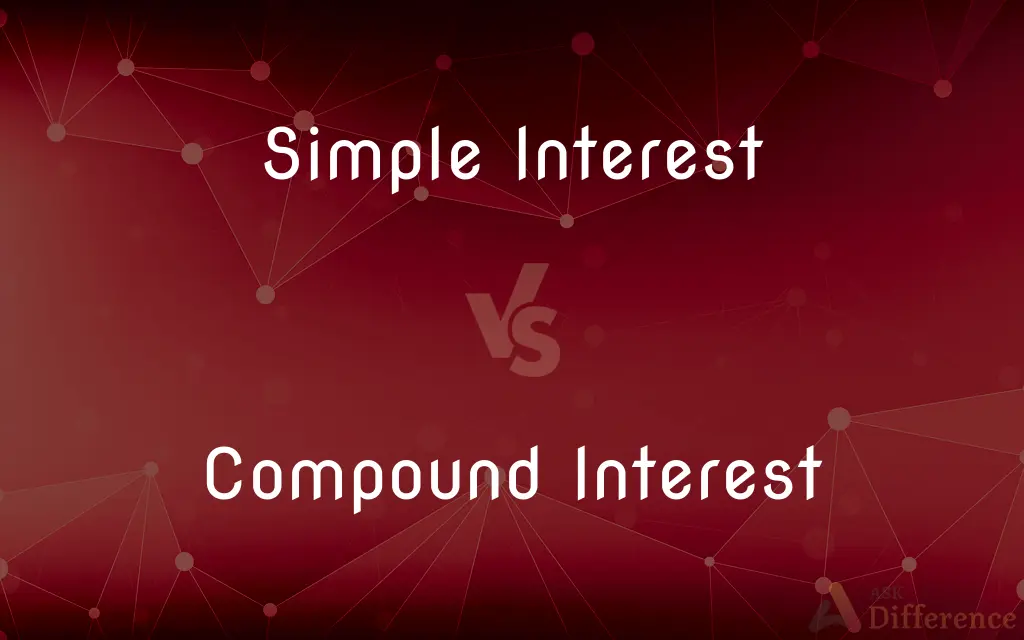Simple Interest vs. Compound Interest — What's the Difference?
By Tayyaba Rehman — Published on October 28, 2023
Simple Interest grows at a constant rate on the initial principal, while Compound Interest grows on both the initial principal and accumulated interest.

Difference Between Simple Interest and Compound Interest
Table of Contents
ADVERTISEMENT
Key Differences
Simple Interest and Compound Interest are fundamental concepts in finance, representing different methods of calculating interest on a sum of money. Simple Interest is calculated on the original principal for the entire period of the loan or investment, without considering the interest that accrues. It’s straightforward, easy to calculate, and the interest amount remains constant over time, making it a preferred choice for short-term loans and investments.
Compound Interest, conversely, is calculated on the initial principal as well as on the accumulated interest of previous periods. It makes the invested amount grow at a faster rate as interest is earned on interest, making it preferable for long-term investments. The effect of compounding can significantly enhance the value of investments, particularly when the interest is compounded frequently.
Simple Interest provides a linear growth to the investment or loan, where the interest amount is a fixed percentage of the initial principal, making it simpler to understand and calculate. It is generally used in situations where the time frame is limited and the principal amount remains unchanged, such as in certain types of loans and financial products.
On the other hand, Compound Interest provides exponential growth, where the interest amount is a result of the initial principal and the accumulated interest being compounded over time. It is prevalent in various financial products like savings accounts, investment funds, and is pivotal for maximizing returns in long-term investments due to the effect of compounding.
In summation, while Simple Interest offers straightforward and constant growth on the original principal, Compound Interest leverages the power of compounding to offer exponential growth on both principal and accumulated interest, proving beneficial in long-term financial strategies.
ADVERTISEMENT
Comparison Chart
Calculation
Calculated on the original principal
Calculated on both the initial principal and accumulated interest
Growth Type
Provides linear growth
Provides exponential growth
Interest Amount
Remains constant over time
Increases over time due to compounding
Preferred Time Frame
Suitable for short-term investments and loans
Beneficial for long-term investments
Usage
Utilized in certain loans and financial products
Common in savings accounts and investment funds
Compare with Definitions
Simple Interest
Typically used for short-term loans and investments.
Simple Interest is straightforward and suitable for situations with a limited timeframe.
Compound Interest
The interest amount increases over time due to the effect of compounding.
The wealth accumulation is significant in Compound Interest as it compounds over time.
Simple Interest
Remains constant and does not compound over time.
The investor chose Simple Interest as the interest amount remains constant over the period.
Compound Interest
The effect of compounding can significantly enhance the value of investments.
Compound Interest proves beneficial when interest is compounded frequently, amplifying investment value.
Simple Interest
A method where interest is calculated on the original principal throughout the loan period.
Simple Interest is ideal for short-term loans due to its linear and predictable growth.
Compound Interest
Frequently used in savings accounts, investment funds, and various financial products.
Compound Interest is prevalent in financial products designed to optimize wealth growth.
Simple Interest
Does not consider the interest that accrues on the invested or borrowed amount.
Simple Interest is calculated solely on the initial principal, ignoring accrued interest.
Compound Interest
Provides exponential growth, maximizing returns in long-term investments.
Investors often opt for Compound Interest to leverage the benefits of compounding.
Simple Interest
Provides linear growth and is easy to calculate.
The predictability and ease of calculation make Simple Interest preferred in certain financial scenarios.
Compound Interest
A method where interest is calculated on both the initial principal and the accumulated interest.
Compound Interest is preferable for long-term savings due to its exponential growth.
Common Curiosities
How is Simple Interest calculated?
Simple Interest is calculated on the original principal throughout the loan or investment period.
Does Compound Interest offer exponential growth?
Yes, Compound Interest provides exponential growth as it is calculated on both the principal and accumulated interest.
Is Simple Interest suitable for short-term investments?
Yes, due to its linear and predictable growth, Simple Interest is suitable for short-term investments and loans.
Is Compound Interest calculated on accumulated interest as well?
Yes, Compound Interest is calculated on both the initial principal and the accumulated interest of previous periods.
Can Compound Interest increase the value of investments significantly over time?
Yes, due to the effect of compounding, Compound Interest can significantly enhance the value of investments over time.
Does the interest amount in Simple Interest remain constant over time?
Yes, the interest amount in Simple Interest remains constant and does not compound over time.
Share Your Discovery

Previous Comparison
Tiles vs. Mosaic Tiles
Next Comparison
Moment of Inertia vs. Polar Moment of InertiaAuthor Spotlight
Written by
Tayyaba RehmanTayyaba Rehman is a distinguished writer, currently serving as a primary contributor to askdifference.com. As a researcher in semantics and etymology, Tayyaba's passion for the complexity of languages and their distinctions has found a perfect home on the platform. Tayyaba delves into the intricacies of language, distinguishing between commonly confused words and phrases, thereby providing clarity for readers worldwide.
















































